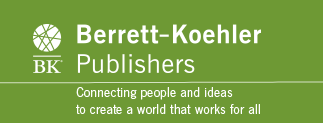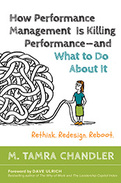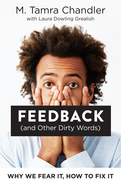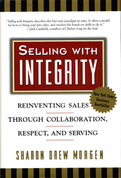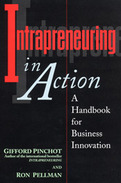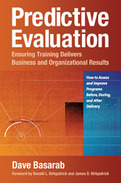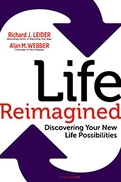Most people associate performance management with the annual review, which is universally dreaded by employees, management, and HR professionals alike. It's a cookie-cutter, fear-based, top-down approach that emphasizes negatives over positives and stifles healthy career conversations. It's never been shown to motivate anyone to do anything but try to avoid it, but nobody feels like they have any alternative. Tamra Chandler has one—and it works.
Actually, Chandler doesn't offer a single alternative—she offers an infinite number of them. Each organization that uses her Performance Management Reboot is able to develop its own unique version since it doesn't make a lot of sense for organizations with different cultures, in different industries and sectors, to do things exactly the same way. Grounded in the latest scientific findings about motivation, it's a transparent, employee-driven process that values collaboration over competition and rewards people for acquiring new skills and increasing their contribution instead of hitting arbitrary benchmarks.
Chandler lays out the general principles and then walks you through each step in creating a performance management process that employees will actually embrace rather than avoid and that will help you meet the three objectives of great performance management: developing your people, rewarding them equitably, and driving your organization's performance. It's the first comprehensive, step-by-step guide to creating a performance management solution that's tailored to your organization's needs and goals and that places the emphasis squarely on your greatest asset: your people.
Feedback: the mere mention of the word can make our blood pressure rise and our defenses go up. For many of us, it's a dirty word that we associate with bias, politics, resentment, and self-doubt. However, if we take a step back and think about its true intent, we realize that feedback needn't be a bad thing. After all, understanding how others experience us provides valuable opportunities to learn and grow.
Authors M. Tamra Chandler and Laura Grealish explain how feedback got such a bad rap and how to recognize and minimize the negative physical and emotional responses that can erode trust and shut down communication. They offer a new and more ambitious definition of feedback, explore the roles we each play as Seeker, Extender, and Receiver, and introduce the three Fs of making feedback focused, fair, and frequent. You'll also find valuable exercises and strategies, along with real-world examples that illustrate how you can put these ideas into action and join in the movement to fix feedback, once and for all.
When it's done right, feedback has been proven to be the most effective means of improving communication and performance for you and your organization. It's too important to give up, and with Chandler and Grealish's help, you'll be able to use it deftly, equitably, and effectively.
Outlines a definitive process for determining the effectiveness and business impact of training.
-
Outlines a definitive process for determining the effectiveness and business impact of training
-
Works with any training program in any setting and at any stage of development
-
A how-to guide filled with worksheets, examples, and other tools
At last, an answer to the question that had bedeviled trainers for decades: how do you make the business case for training? Predictive evaluation enables you to effectively and accurately forecast training's value to your company, measure against these predictions, establish indicators to track your progress (and make midcourse corrections if needed), and report the results in a launguage that business executives respond to and understand. It's an approach that can be used for any sort of training program, in any setting, whether planned, newly implemented, or long established.
Dave Basarab explains how to begin by zeroing in on the program's intentions: what specific goals and beliefs do you want to instill in participants? The next step is to determine what these will look like when put into action -- what precise on-the-job actions and behaviors do you expect to see if these goals and beliefs are adopted? Finally, you develop quantifiable measures of how employees' adopting the target beliefs and goals will impact the business. In the end, all the information is pulled togethr into an Impact Matrix that provides a definitive picture of the program's intended and actual bottom-line results.
A key strength of predictive evaluation is that it is profoundly collaborative. Supervisors and employees work together to establish standards for success each step of the way. This guarantees the results will be relevant to the business and gives all participants a sense of ownership in the process.
Predictive evaluation will greatly enhance training's acceptance as a business function like any other, one where projections are made, progress is measured, and effectiveness is definitely determined. Rather than being regarded as an expense and an act of faith, training will be seen as an investment with a concrete payoff.
2013
Are You Ready for Your Life Reimagined Moment?
Are you at a point in your life where you're asking, “What's next?” You've finished one chapter and you have yet to write the next one. Many of us face these transitions at midlife, but they can happen at any point. It's a time full of enormous potential, and it defines a whole new phase of life. It's called Life Reimagined.
Here is your map to guide you in this new life phase. You can use the powerful practices and insights—enhanced with online tools and exercises at AARP's LifeReimagined.org website—to help you uncover your own special gifts, connect with people who can support you, and explore new directions.
You'll be inspired by meeting ordinary people who have reimagined their lives in extraordinary ways. You'll also read the stories of pioneers of the Life Reimagined movement such as Jane Pauley, James Brown, and Emilio Estefan. They show us that this journey of discovery can help us find fulfillment in surprising new places.
One of the profound truths that underlies this book is the liberating notion that each of us is “an experiment of one,” free to find our own path in this new phase of our lives. No old rules, no outdated societal norms, no boundaries of convention or expectation. Let Life Reimagined help you discover your new life possibilities!
